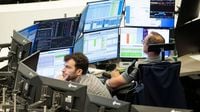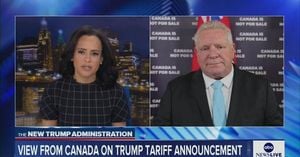On April 3, 2025, the price of gold soared to a historic high of $3,167.84 per fine ounce, driven by a combination of geopolitical tensions and aggressive U.S. tariff policies. This surge marks a significant milestone in the precious metal's ongoing rally, reflecting not only market volatility but also its status as a safe haven for investors amid global uncertainty.
The recent spike in gold prices has been attributed to U.S. President Donald Trump's announcement of sweeping tariffs on imports, which has sent shockwaves across financial markets worldwide. Analysts have noted that these tariffs, which impose a 20% surcharge on European imports and a staggering 34% on Chinese goods, have intensified fears of an economic downturn, prompting investors to flock to gold as a reliable asset.
Gold has become increasingly attractive, with its price rising by nearly 20% in 2025 alone, following a nearly 50% increase over the previous three years. According to Deutsche Bank expert Michael Hsueh, the extraordinary demand for gold, which has pushed its valuation well above normal levels, is expected to persist. "The high demand will continue, especially from central banks and Chinese insurers," Hsueh stated.
The price rally began gaining momentum in mid-March when gold broke the $3,000 mark, leading to celebrations among investors. Shortly thereafter, it surpassed the psychologically significant threshold of $3,100. As of April 2, the price had reached $3,126.93, with expectations of further increases spurred by the recent tariff announcements.
Market analysts are closely monitoring resistance levels, with key targets set at $3,190, $3,240, and $3,280. Conversely, support levels are identified at $3,057, $3,007, and $2,978. A break below the previous day's low of $3,104 could signal weakness, while a decisive drop below $3,057 would indicate a potential correction towards the $3,000 mark.
Despite the bullish outlook, Frank Schallenberger, a commodity expert at Landesbank Baden-Württemberg, cautions that gold may now be overbought. He warned that gold's correlation with stock markets has increased, suggesting that a downturn in equities could also impact gold prices. "Gold has become a risk asset in its own right," Schallenberger remarked. He predicts that by the end of 2025, gold prices may settle around $2,800.
Amid the soaring gold prices, demand for gold-backed exchange-traded commodities (ETCs) has surged, with providers increasing their holdings by over 150 tons this year. This trend contrasts sharply with the previous four years, during which gold sales dominated. Schallenberger noted that central banks have consistently purchased over 1,000 tons of gold annually for the past three years, significantly outpacing average purchases from 2012 to 2019.
On the jewelry front, however, demand has taken a hit, with approximately 450 tons less gold requested for jewelry production in 2024 compared to historical averages. This decline in jewelry demand has been partially offset by increased central bank purchases.
Investors have several options for acquiring gold, including physical coins and bars, which can be purchased from banks and online retailers. However, the costs associated with secure storage and the spread between buying and selling prices can eat into profits. Alternatively, gold ETCs, such as Xetra Gold and Euwax Gold 2, offer a more accessible investment route, allowing investors to trade gold as they would stocks.
For those interested in mining stocks, gold mining companies have seen a resurgence, with shares outperforming the broader market recently. Newmont, the largest publicly traded gold producer, made headlines in 2023 by acquiring Australian competitor Newcrest Mining for $19.2 billion, marking one of the industry's largest mergers. Newmont's gold reserves are estimated at 136 million ounces, a significant asset in a booming market.
In the wake of Trump's tariff announcements, global markets reacted sharply. The DAX index in Germany fell to its lowest level since early February, losing 2.3% and closing at 21,873 points. The Nikkei index in Tokyo also dropped by over 3%, reflecting widespread investor anxiety. As safe-haven assets gained traction, gold prices climbed, while government bond prices rose in response to the turmoil.
As the financial landscape continues to evolve, investors remain vigilant, weighing the potential risks and rewards associated with gold investments. The recent surge in prices underscores gold's enduring appeal as a hedge against economic uncertainty, but experts warn that market dynamics could shift rapidly, necessitating a cautious approach.
In summary, the gold market is currently experiencing unprecedented growth fueled by geopolitical tensions and economic policy shifts. As investors navigate this landscape, the allure of gold as a secure investment remains strong, even as experts urge caution regarding potential corrections in the future.







